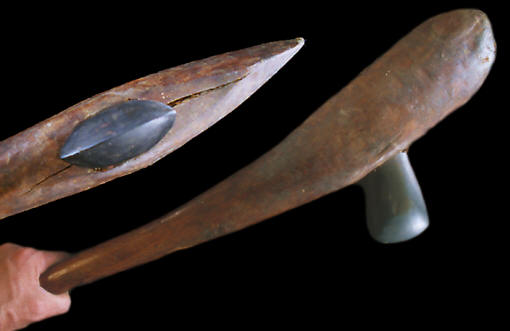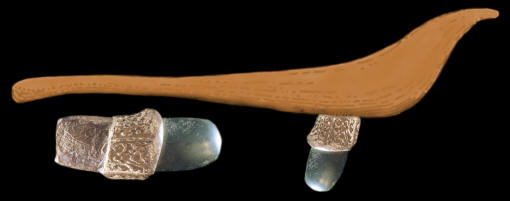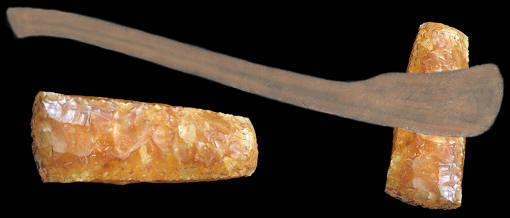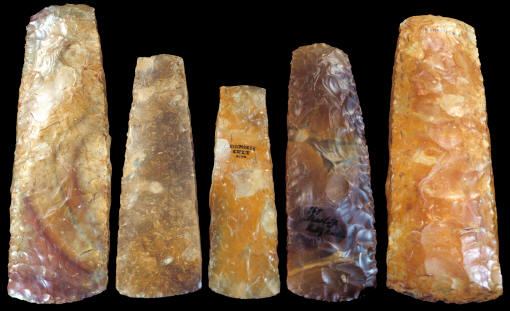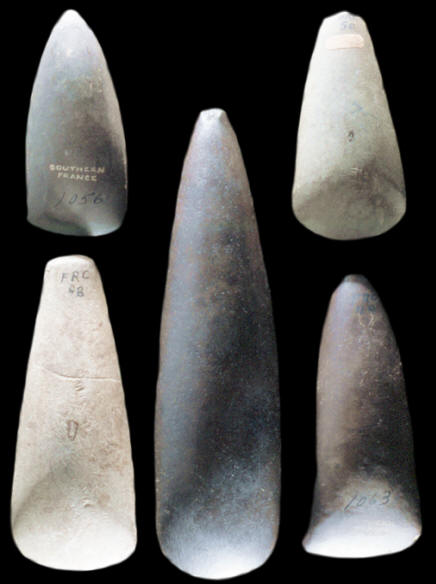|
|
|
Stone axes were secured to handles in several different ways. One technique, used by North American Indians, involved adhesives made from animal, vegetal or mineral ingredients. Another technique simply holds the axe in place with friction when the axe is wedged tight enough into the handle. Various types of natural fibers and other materials were also used to tightly wedge the axe in place. Some axes may also have been attached to a handle with the use of strips of animal hide or sinew. |
|
|
Axe handles are generally made from harder woods that can withstand heavy use. Repeated chopping and hammering eventually splits the hafting area. The Swiss Lake culture in Europe invented a device that extended the life of the handle by, "fixing the blade (stone axe) in a socket of deer-horn, the elasticity of which deadened the effect of the blows upon the wood (1902)." Fine grained harder woods are also a good medium for carving. Some of the rare ancient examples that have been found have decorative carving on their surfaces. The handles in this article range in size up to 28 7/8 inches in length (73.2 cm) long. |
|
|
|
|
Axes have a wide range of sizes. They can be as small as less than an ounce or up to twenty pounds. The smallest examples may have been hafted in short handles and used as chisels. Other small ungrooved axes may have been made for a child's toy. Most axes were used for chopping wood but the largest axes were probably used to break ice in the winter to access water or they may have been used to pound stakes in the ground. |
|
|
|
|
The first experiments concerning the felling of trees with stone axes occurred in the late 1800's by Vicomte Lepic who used a polished axe hafted with an oak root to cut down an oak tree. In the 1920's a Danish archaeologist named Sechested built a house with local Neolithic tools. He is reported to have cut down 26 pine trees with an average diameter of 8 inches (20.3cm) in ten hours, without resharpening the axe. S. A. Semenov reports that in 1951 an experiment was carried out near Leningrad where a Neolithic period nephrite axe was used to cut through a 25 cm (9.84 inches) tree in twenty minutes. In 1954 a trial clearance of 2000 square meters of oak forest was accomplished in Denmark. Neolithic style flint axes were hafted in copies of ancient handles. They cut down all the trees that were under 35 cm (13.78 inches) in diameter at knee height. Three men were able to clear 500 square meters in four hours. The experiment concluded that one man could have cleared 2 hectare in a week. In the late 1960's an experiment in Czechoslovakia, using a polished stone axe, found that a tree between 14 (5.51 inches) and 15 cm (5.9 inches) in diameter could be cut down in seven minutes. Experiments with various types of stone axes have continued to this day and most of the conclusions concern the efficiency of stone axes. |
|
|
Stone axes would have served many useful purposes over the last several thousands years. They are mainly wood cutting tools that were used for such projects as clearing land, gathering firewood, constructing houses and building defensive walls. They would also have served as weapons to fight off enemies or animals. But axes would also have been used for many other purposes such as splitting wood or breaking ice. |
|
|
|
|
The fact that stone axes are found all over the world on several different continents illustrates the inventive mind of humans everywhere. The surface of the earth is littered with similar types stone tools that were developed for specific purposes. Many of them seem to have been reinvented over and over by people who were separated by space and time. |
|
|
"REFERENCES"
1895,
Clodd, Edward, "Primitive Man," pp. 91-92. |
|

